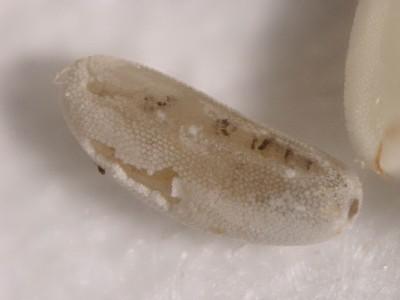About flower flies
- Flower flies (Family: Syrphidae) are beneficial predators
- Flower flies are also known as hoverflies or syrphid flies.
- They are common aphid predators in the garden and landscape.

Appearance
- The adults resemble bees, with yellow and black, or white and black striped abdomens. Often confused with sweat bees, they are stingless flies that mimic the appearance of small bees in order to avoid predators.
- They are 1/8 to 5/8 of an inch long and are often found hovering over flowers like hummingbirds feeding on nectar.
Where to find them
- Frequently found swarming around – and sometimes landing on - humans, likely attracted to moisture and salts on our skin.
- Exhibit a characteristic flight pattern they hover and can abruptly change position, earning them the nickname "hoverflies".
- Adults are mainly nonselective pollinators, feeding on nectar and pollen from a variety of plants and agriculturally important crops including strawberries, peppers, pears, and almonds.
- Generally, prefer white and yellow-colored flowers and due to their short mouthparts, most also prefer flowers with a more open shape. They allow the nectar and pollen to be more easily accessed.
- Some species appear to be less affected by land-use changes than many bee species. They are better able to use resources from highly modified habitats – including agricultural fields.
Flower fly life stages
- The larval stages of many Syrphid species are also beneficial in the landscape, preying on soft-bodied pest insects like aphids and thrips.
- The adult female fly lays eggs near aphid colonies, and may often be seen flying around aphid-infested plants.
- The eggs hatch into larvae (maggots) that may be grayish or greenish, and are somewhat translucent. These larvae consume large numbers of aphids before moving off the foliage into the soil to pupate.
- Adult flower flies must have nectar. Grow perennial and annual flowers to attract them. They are not currently available commercially.
Contributor: University of Maryland graduate student Veronica Yurchak. February 2020
 English
English العربية
العربية Български
Български 简体中文
简体中文 繁體中文
繁體中文 Hrvatski
Hrvatski Čeština
Čeština Dansk
Dansk Nederlands
Nederlands Suomi
Suomi Français
Français Deutsch
Deutsch Ελληνικά
Ελληνικά हिन्दी
हिन्दी Italiano
Italiano 日本語
日本語 한국어
한국어 Norsk bokmål
Norsk bokmål Polski
Polski Português
Português Română
Română Русский
Русский Español
Español Svenska
Svenska Català
Català Filipino
Filipino עִבְרִית
עִבְרִית Bahasa Indonesia
Bahasa Indonesia Latviešu valoda
Latviešu valoda Lietuvių kalba
Lietuvių kalba Српски језик
Српски језик Slovenčina
Slovenčina Slovenščina
Slovenščina Українська
Українська Tiếng Việt
Tiếng Việt Shqip
Shqip Eesti
Eesti Galego
Galego Magyar
Magyar Maltese
Maltese ไทย
ไทย Türkçe
Türkçe فارسی
فارسی Afrikaans
Afrikaans Bahasa Melayu
Bahasa Melayu Kiswahili
Kiswahili Gaeilge
Gaeilge Cymraeg
Cymraeg Беларуская мова
Беларуская мова Íslenska
Íslenska Македонски јазик
Македонски јазик יידיש
יידיש Հայերեն
Հայերեն Azərbaycan dili
Azərbaycan dili Euskara
Euskara ქართული
ქართული Kreyol ayisyen
Kreyol ayisyen اردو
اردو বাংলা
বাংলা Bosanski
Bosanski Cebuano
Cebuano Esperanto
Esperanto ગુજરાતી
ગુજરાતી Harshen Hausa
Harshen Hausa Hmong
Hmong Igbo
Igbo Basa Jawa
Basa Jawa ಕನ್ನಡ
ಕನ್ನಡ ភាសាខ្មែរ
ភាសាខ្មែរ ພາສາລາວ
ພາສາລາວ Latin
Latin Te Reo Māori
Te Reo Māori मराठी
मराठी Монгол
Монгол नेपाली
नेपाली ਪੰਜਾਬੀ
ਪੰਜਾਬੀ Afsoomaali
Afsoomaali தமிழ்
தமிழ் తెలుగు
తెలుగు Yorùbá
Yorùbá Zulu
Zulu ဗမာစာ
ဗမာစာ Chichewa
Chichewa Қазақ тілі
Қазақ тілі Malagasy
Malagasy മലയാളം
മലയാളം සිංහල
සිංහල Sesotho
Sesotho Basa Sunda
Basa Sunda Тоҷикӣ
Тоҷикӣ O‘zbekcha
O‘zbekcha አማርኛ
አማርኛ Corsu
Corsu Ōlelo Hawaiʻi
Ōlelo Hawaiʻi كوردی
كوردی Кыргызча
Кыргызча Lëtzebuergesch
Lëtzebuergesch پښتو
پښتو Samoan
Samoan Gàidhlig
Gàidhlig Shona
Shona سنڌي
سنڌي Frysk
Frysk isiXhosa
isiXhosa


